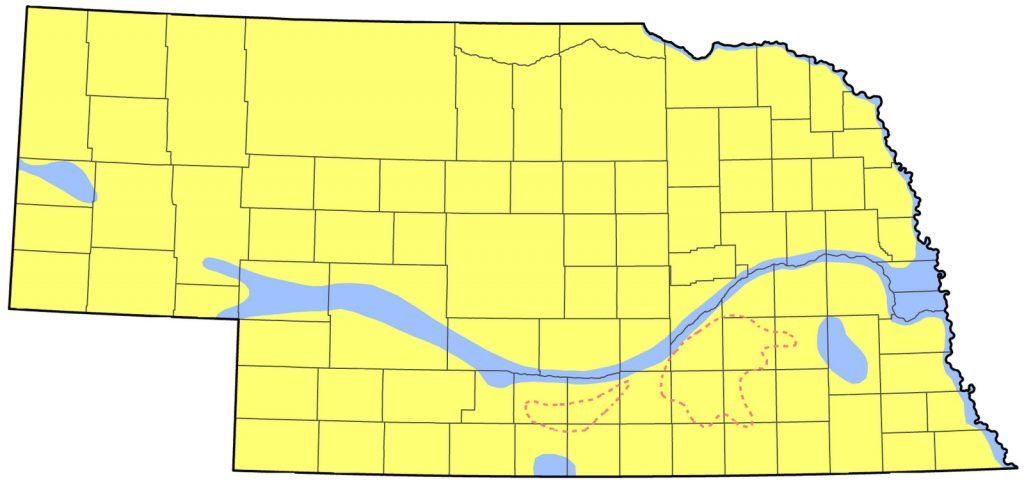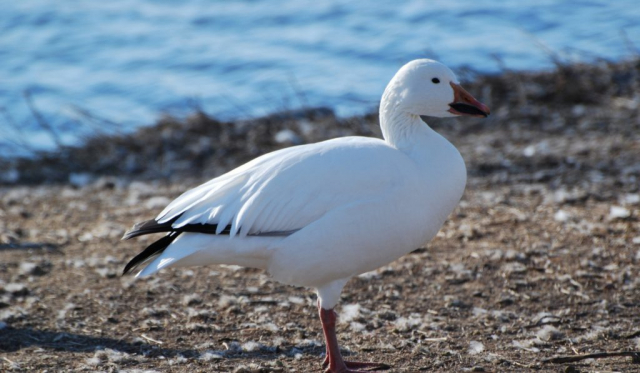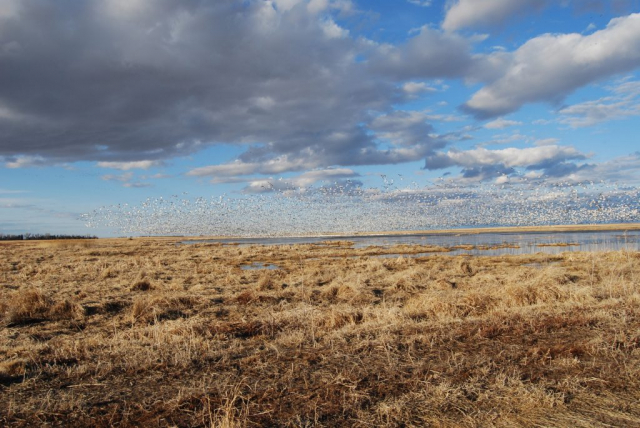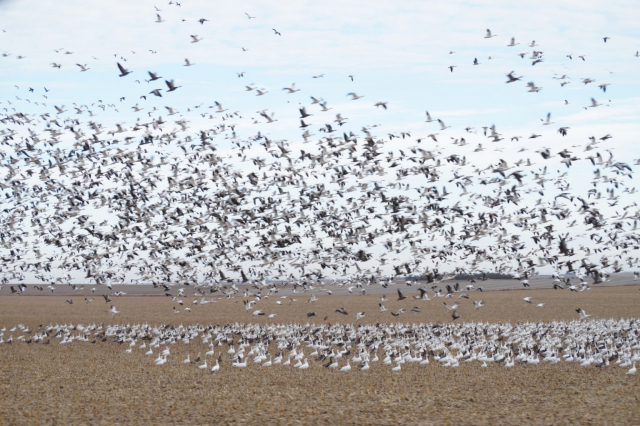Anser caerulescens caerulescens, A. c. atlanticus
Status: Abundant regular spring migrant east, south and west, uncommon north. Uncommon regular summer visitor statewide. Abundant regular fall migrant central and east, common west. Uncommon regular winter visitor east, south and west, rare north.

Documentation: caerulescens: specimen UNSM ZM10619, 28 Mar 1917 Lancaster Co; atlanticus: photograph by William Lemburg of a specimen provided by Randy Buettner in spring, circa 2000 (Silcock 2004).
Taxonomy: The genus Chen was recently lumped with genus Anser based on genetic studies (Chesser et al 2017).
Until the late 1960s, the blue and white color morphs (formerly “phases”) of Snow Goose were treated as separate species, westerly-distributed Snow Goose, A. hyperborea, and easterly-distributed Blue Goose, A. caerulescens. Their breeding ranges had been separated until range expansion led to mixing of the two in the 1930s (Cooke et al 1995). Genetic studies established that they were indeed color morphs of a single species (Cooch 1961), the “blue allele” being “incompletely dominant” to the “white allele” (Mowbray et al 2020). Breeding populations tend to migrate as a unit more or less directly southward and at this writing (2023) the white morph overwhelmingly predominates in the Nebraska Panhandle, whereas both morphs occur in eastern Nebraska.
Two subspecies of A. caerulescens are recognized (AviList 2025): caerulescens, breeding from northeast Siberia to northwest Canada, wintering in the southern United States and northern Mexico, and atlanticus, breeding in northeast Canada and Greenland, wintering on the Atlantic Coast.
Essentially all Nebraska Snow Geese are caerulescens, but there are six records of eastern atlanticus. Occurrence of atlanticus in Nebraska was discussed by Silcock (2004), who cited five documented records 2000-2003. In addition to these five records, a single atlanticus, collar # JK41, was seen 15-16 Mar 2002 in Thayer Co (Kathy Meeres, personal communication). Since the 1990s there has been a shift westward by atlanticus from its traditional Atlantic Coast migratory route which has led to the occurrence of low numbers, estimated at fewer than 30 birds annually, in the Central Flyway (Silcock 2004).
There are Nebraska records of Snow Goose hybrids with Ross’s Goose, Greater White-fronted Goose, Cackling Goose, and Canada Goose; see Snow x Ross’s Goose (hybrid), Snow X Greater White-fronted Goose (hybrid), Snow x Cackling Goose (hybrid), and Snow x Canada Goose (hybrid).
Spring: There are several winter and summer records that make it difficult to determine spring arrival and departure dates, however during mid- to late Feb and early Mar hundreds of thousands or even millions of birds are observed across the state. Arrival of the large influx and the duration of stopover in the state is generally dependent on weather. In some years, peak migration is short-lived, and a majority of birds may move out of the state within a week. In other years, especially during period of prolonged wintry weather, large numbers may remain in the state for 1-3 weeks.
Snow Goose occurrence and distribution patterns in Nebraska have been dynamic for several decades, especially as overall numbers have increased dramatically over time (USFWS 2017). In some areas of the breeding range, numbers increased 25-fold during a 25-year period in the late 20th Century (Mowbray et al 2020). Vrtiska and Sullivan (2009) estimated between 1.3 to 7.3 million “light geese” (Snow and Ross’s Goose) stopped over in the Rainwater Basin and central Platte River Valley during the period 2001-2003.
- High counts: In the Rainwater Basin and central Platte River Valley: 2,000,000 in the central Platte River Valley 15 Mar 2004, 2,000,000 at Harlan Co Reservoir, Harlan Co, 2,000,000 in the central Platte River Valley 23-26 Feb 2005, 1,700,000 in Kearney Co 18 Mar 2019, and 1,500,000 at Harlan Co Reservoir 27 Mar 2013.
- Elsewhere in the east and east central, 500,000-1,000,000 at Branched Oak Lake, Lancaster Co 2 Mar 2017, 500,000 in Platte Co, 26 Feb 2016, and 150,000 over Nemaha Co 11 Feb 2017.
- In the west and west central, 2,000,000 at Sutherland Reservoir, Lincoln Co 13 Mar 2023, 549,023 there 1 Mar 2025, and 50-75,000 in Scotts Bluff Co 11 Mar 2008.
- A carefully documented estimate was made of 1,074,080 passing over Nuckolls Co from 10.20 am to 12.16 pm on 4 Feb 2017 (David Ely, personal communication).
Summer: There are many summer (mid-Jun through Sep) records, often involving injured or diseased individuals, although apparently healthy singles and small groups are not uncommon, especially in the Rainwater Basin. There are a few records of good numbers through early Jun (see High Counts).
Evidence for breeding is equivocal. The propensity for injured birds to summer, along with their healthy mates, may be interpreted as nesting by some observers. Ducey (1988) discussed published reports, two of which are indicative of nesting. Swenk (Notes Before 1925) related that a nest with eggs along the Platte River south of Kearney was seen by C. A. Black (Black 1908), although when Black arrived the nest was destroyed but still attended by two Snow Geese. Four Snow Geese were said to be nesting at Home Lake, Sheridan Co, in 1929 (Ducey 1988). Two additional undocumented reports of breeding are on file at NGPC: a pair with young was observed Jun 1990 at Willow Creek Lake SRA, Pierce Co, and two goslings were produced by a pair, one of which was injured, at a recharge lake west of York, York Co in 1996.
- High counts (mid-Jun through Sep): 30 at Kea Lake WMA, Buffalo Co 9-21 Jun 2025, 29 at Lakes North and Babcock, Platte Co 18 Jun 2018, and 23 at Lake Wanahoo, Saunders Co 21 Jun 2023.
Fall: Fall migration is variable and is dependent on weather and food conditions, as well as hunting pressure. Peak numbers probably occur later in fall than previously; some 50,000 at Plattsmouth WMA (now Schilling WMA), Cass Co in Oct 1969 was considered peak migration there (Plattsmouth Journal article). Snow Geese may remain well into Dec and into Jan in mild winters. Far fewer occur in the west in fall than in spring (Rosche 1994, Brown and Brown 2001).
- High counts: In the west and west central: 60,000 at Lakeview, Lake McConaughy, Keith Co 7 Dec 2022, 20,000 at Swanson Reservoir, Hitchcock Co 26 Nov 2022, and 10,000 at Lake McConaughy 8 Nov 2019.
- In the east and east central: 116,000 in Nuckolls Co 25 Nov 2020, and 30,000 at Harlan County Reservoir, Harlan Co 26 Nov 2022.
Winter: Numbers are generally lowest 10-20 Jan; notable midwinter high counts westerly were 17,000 at Sutherland Reservoir, Lincoln Co 20 Jan 2024 and 10,000 in Cheyenne Co 31 Jan 2022. Farther east, 21,000 were counted in Nuckolls Co 18 Jan 2020, the highest count on record for the 10-20 Jan period. However, as many as 50,000 have remained near Clay Center, Clay Co in mild winters (Joe Gabig, personal communication) and more recently 30,000-40,000 were recorded during the mid-winter waterfowl survey conducted by NGPC in early Jan 2020 (Mark Vrtiska, personal communication). Small groups occasionally move north into the state in mid-winter from overwintering areas in Kansas and Missouri during extended warm spells, but the species may also be mostly absent during very cold winters.
Images
Abbreviations
NGPC: Nebraska Game and Parks Commission
NWR: National Wildlife Refuge
SRA: State Recreation Area
UNSM: University of Nebraska State Museum
USFWS: United States Fish and Wildlife Service
Acknowledgement
Mark P. Vrtiska, NGPC, provided numerous helpful comments that improved this species account.
Literature Cited
AviList Core Team, 2025. AviList: The Global Avian Checklist, v2025. https://doi.org/10.2173/avilist.v2025.
Black, C.A. 1908. Breeding of the Snow Goose in Nebraska. Warbler 4: 15.
Brown, C.R., and M.B. Brown. 2001. Birds of the Cedar Point Biological Station. Occasional Papers of the Cedar Point Biological Station, No. 1.
Chesser, R.T., K.J. Burns, C. Cicero, J.L. Dunn, A.W. Kratter, I.J. Lovette, P.C. Rasmussen, J. V. Remsen, Jr., J.D. Rising, D.F. Stotz, and K. Winker. 2017. Fifty-eighth supplement to the American Ornithological Society’s Check-list of North American Birds. Auk 134: 751-773.
Cooch, G. 1961. Ecological aspects of the Blue-Snow Goose Complex. Auk 78: 72-89.
Cooke, F., and G. Cooch. 1968. The genetics of polymorphism in the Goose Anser caerulescens. Evolution 22: 289-300.
Ducey, J.E. 1988. Nebraska birds, breeding status and distribution. Simmons-Boardman Books, Omaha, Nebraska, USA.
Jorgensen, J.G. 2012. Birds of the Rainwater Basin, Nebraska. Nebraska Game and Parks Commission, Lincoln, Nebraska, USA.
Mowbray, T.B., F. Cooke, and B. Ganter. 2020. Snow Goose (Anser caerulescens), version 1.0. In Birds of the World (P. G. Rodewald, Editor). Cornell Lab of Ornithology, Ithaca, NY, USA. https://doi.org/10.2173/bow.snogoo.01.
Rosche, R.C. 1994. Birds of the Lake McConaughy area and the North Platte River valley, Nebraska. Published by the author, Chadron, Nebraska, USA.
Silcock, W.R. 2004. The Greater Snow Goose (Chen caerulescens atlanticus) in Nebraska. NBR 72: 104-108.
Swenk, M.H. Notes before 1925. Bird notes from A.M. Brooking of Hastings, C.A. Black of Kearney, and B.J. Olson of Kearney, based chiefly on their collections, up to January 1, 1925. Typed manuscript in the Nebraska Ornithologists’ Union Archives, University of Nebraska State Museum, Lincoln, Nebraska, USA.
USFWS [U.S. Fish and Wildlife Service]. 2017. Waterfowl population status, 2017. U.S. Department of the Interior, Washington, D.C. USA.
Vrtiska, M.P., and S. Sullivan. 2009. Abundance and distribution of Lesser Snow and Ross’s geese in the Rainwater Basin and central Platte River Valley of Nebraska. Great Plains Research 19: 147-55
Recommended Citation
Silcock, W.R., and J.G. Jorgensen. 2025. Snow Goose (Anser caerulescens). In Birds of Nebraska — Online. www.BirdsofNebraska.org
Birds of Nebraska – Online
Updated 19 Aug 2025



